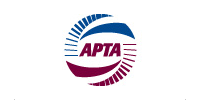
Nearly 2.6 billion trips were taken on U.S. public transportation in the first quarter of 2016, according to a report released today by the American Public Transportation Association (APTA), representing a slight increase of 0.4 percent. Rail ridership saw significant increases, with light rail showing the largest increase of 3.0 percent.
“On a national level, public transit ridership was slightly up for the first quarter of 2016, with solid increases in light rail, heavy rail (subways), and commuter rail,” said Valarie J. McCall, APTA Chair and board member of the Greater Cleveland Regional Transit Authority.
Public transportation systems in the following cities reported record ridership for the first quarter: Albany, NY; Flagstaff, AZ; Oklahoma City, OK; and Seattle, WA. Additionally, public transit systems in cities of all sizes saw ridership increases due to economic expansion, as new jobs were added and unemployment decreased. These cities were: Albany, NY, Boston, MA; Detroit, MI; Hartford, CT; Lewisville, TX; Little Rock, AR; New York City, NY; San Antonio, TX; and San Francisco, CA.
Noting that nearly 60 percent of trips taken on public transportation are taken for work commutes, McCall said, “It’s common to see public transit ridership increase when communities are experiencing economic growth.”
Gas prices were significantly lower than the 2015 first quarter. Nationally, the average price of gas during the first quarter of 2016 was $1.80. This quarterly gas average was 40 cents lower than the 2015 first quarter national average, a drop of 18 percent.
“Despite the fact that gas prices were extremely low, nearly 2.6 billion trips were taken on public transportation in the first quarter,” said APTA Acting President and CEO Richard A. White. “It shows public transit services are essential to individuals and the communities they live in.”
To see the complete APTA 2016 Q1 ridership report click here.
2016 First Quarter Ridership Breakdown
Nationally, light rail (modern streetcars, streetcars, and heritage trolleys) ridership increased by 3.0 percent in the first quarter of 2016. Thirteen of 29 light rail systems reported ridership increases. Four light rail systems in the following cities saw double-digit increases in the first quarter: Houston, TX (32.3%); Baltimore, MD (25.1%); Seattle, WA (21.2%); and Newark, NJ (13.5%). Light rail ridership in the following cities also saw increases for the first quarter of 2016: Portland, OR (9.1%); Minneapolis, MN (7.2%); Sacramento, CA (6.5%); Pittsburgh, PA (4.2%); Philadelphia, PA (3.3%); San Francisco, CA (3.1%); Dallas, TX (3.0%); Phoenix, AZ (2.8%); and Charlotte, NC (0.9%).
With the second highest percentage of increase in ridership, commuter rail ridership rose by 2.7 percent in the first three months of 2016. Sixteen of 29 commuter rail systems reported ridership increases. Three commuter rail systems in the following cities saw double-digit increases in the first quarter: Anchorage, AK (29.0%); Boston, MA (19.6%); and Seattle, WA (15.7%). Commuter rail ridership in the following cities also saw increases for the first quarter of 2016: Oakland, CA (9.4%); Nashville, TN (6.8%); Harrisburg-Philadelphia, PA (6.5%); San Carlos, CA (5.8%); Minneapolis, MN (5.7%); Portland, ME (5.2%); Stockton, CA (5.2%); New York, NY-MTA Metro-North Railroad (5.1%); New Haven, CT (3.6%); Newark, NJ (3.6%); Salt Lake City, UT (2.9%); Lewisville, TX (2.1%); and Portland, OR (0.1%).
In the 2016 first quarter, eight out of 15 heavy rail (subways and elevated trains) systems reported ridership increases as heavy rail ridership increased by 2.5 percent nationwide. The heavy rail systems with first quarter increases in ridership were in the following cities: Jersey City, NJ-Port Authority of NY & NJ (8.4%); Lindenwold, NJ-Port Authority Transit Corp. (7.8%); Boston, MA (7.4%); New York, NY-MTA Staten Island Railway (7.2%); San Francisco, CA (5.0%); Chicago, IL (3.3%); New York, NY-MTA New York City Transit (2.8%); and Atlanta, GA (2.5%).
Bus systems that saw ridership increases of more than 5 percent were located in the following cities: Albany, NY (6.1%); Alturas, CA (94.4%); Amherst, MA (11.7%); Anaheim, CA (12.5%); Arlington, VA (19.7%) Aspen, CO (6.7%); Bismarck, ND (13.2%); Boston, MA (7.1%); Clemson, SC (5.7%); Culver City, CA (7.5%); Davis, CA (8.0%); Dayton, OH (7.2%); Detroit, MI (19.6%); Espanola, NM (58.3%); Everett, WA (5.6%); Hartford, CT (8.7%); Ketchum, ID (9.6%); Lewisville, TX (8.7%); Little Rock, AR (9.5%); Missoula, MT 16.8%); Oklahoma City, OK (6.9%); Owensboro, KY (5.1%); Park City, UT (8.8%); San Francisco, CA (8.1%); Toledo, OH (6.2%); Williamsburg, VA (12.0%), and Williamsport, PA (5.2%).
Bus systems in population areas of below 100,000 saw an increase of 0.2 percent. Demand response (paratransit) ridership increased by 3.5 percent, while trolleybus ridership decreased by 1.9 percent.
About American Public Transportation Association
The American Public Transportation Association (APTA) is a nonprofit international association of 1,500 public and private sector organizations, engaged in the areas of bus, paratransit, light rail, commuter rail, subways, waterborne services, and intercity and high-speed passenger rail. This includes: transit systems; planning, design, construction, and finance firms; product and service providers; academic institutions; transit associations and state departments of transportation. APTA is the only association in North America that represents all modes of public transportation. APTA members serve the public interest by providing safe, efficient and economical transit services and products.




Comments
There are no comments yet for this item
Join the discussion